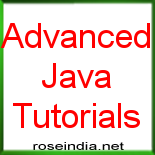Advanced Java Tutorials
In this section you will find the Java topics that should be part of Advanced Java study course. We have extensive collection of Advance Java online course materials. The links to these Advance Java Tutorials are provided for easy reference. You can easily locate the topics of your interest by just clicking on the link provided.
The Advanced Java Tutorials increases the advance java skills and helps the programmers to better utilize the advance features of Java technology. After learning our Advance Java Tutorials you will be able to apply the advance concepts to develop the applications.
To complete the Advance Java Tutorials successfully, you should be familiar and have programming experience in basic Java programming. You must have good exposure to the object-oriented programming (OOP) concepts of Java language.
Objective of Advanced Java Tutorials/ Advance Java Online Training
After completing the Advanced Java Tutorials/online Training course, the candidates will be able to:
- Use the advanced features of Java Technology
- Develop good program to handle exceptions and errors in program.
- Work with collection API and develop fast programs.
- Use the java.io package in detail.
- Use the serialization concepts of java technology.
- Develop good multithreaded programs
- Work the latest JDBC technology
- Learn Java Generics
Advanced Java Programming Course
Here the topics that you should master as part of your advance java study.
- Generics
- Introduction to Generics
- Examples of Generics
- Type Erasure
- Type Boundaries
- Wildcards
- What is Generic Methods?
- Generic Methods Example
- Strengths and Weaknesses of Generics
- Legacy Code and Generics
- Threads
- Reflection
- The Reflection API
- Getting the implemented Interfaces
- Retrieving the class name through Reflection API
- Finding out the superclass name of the Class
- Getting the method name used in the Application
- Finding out the object of the Class
- Finding out the class fields
- Getting information about Constructor
- No Argument Constructor Example
- Class Modifier Example
- Calling ( Invoking ) Methods through Reflection
- The Class<T> Class
- The java.lang.reflect Package
- Reading Type Information
- Navigating Inheritance Trees
- Dynamic Instantiation
- Dynamic Invocation
- Reflecting on Generics
- Uses for Meta-Data
- Annotations
- What is Annotations in Java?
- Annotation Quick Introduction
- Java Custom Annotation Example
- Aspect-Oriented Programming and Java
- The Annotations Model
- Annotation Types and Annotations
- Built-In Annotations
- Annotations vs. Descriptors (XML)
- Sockets (Java networking)
- The OSI Reference Model
- Network Protocols
- Overview of Networking through JAVA
- Socket and ports
- Server Sockets
- URL in term of Java Network Programming
- Datagram in network environment
- Networking in Java
- The Socket Class
- The ServerSocket Class
- Connecting Through URL Objects
- Find Your Host Name/IP Address
- How to retrieve URL information
- Construct a DatagramPacket to receive data
- Open a URLConnection to specific website address
- Getting Image from a URL
- Echo ClientSocket Example
- Client Socket Information
- RMI Client And RMI Server Implementation
- HTTP and Other TCP Servers
- Datagram Clients and Servers
- Non-Blocking Sockets
- Database and SQL Fundamentals
- Database Management System
- Relational Databases
- SQL
- Database, Schema, Tables, Columns and Rows
- SQL Versions and Vendor Implementations
- Introduction to DDL (Creating and Managing Database Objects) and DML (Retrieving and Managing Data)
- Sequences
- Stored Procedures
- Using SQL Terminals
- JDBC Fundamentals
- Advanced JDBC
- SQL Escape Syntax
- Using Prepared Statements
- Using Callable Statements
- Scrollable Result Sets - JDBC ResultSet Scroll Insensitive Type Example | JDBC ResultSet Scroll Sensitive Type Example
- Updatable Result Sets
- JDBC ResultSet Delete Row Example
- Transactions
- Commits, Rollbacks, and Savepoints
- Batch Processing (Many Examples)
- Introduction to Row Sets
- Row Sets in GUI and J2EE programming
- JDBC RowSet Example
- Advantages of RowSets
- RowSet Specializations
- Using CachedRowSets
- Design Patterns
- What are Design Patterns?
- Singleton, Factory Method, Abstract Factory
- Adapter, Composite, Decorator
- Chain of Responsibility, Observer / Publish-Subscribe, Strategy, Template
- Data Access Object (DAO)
